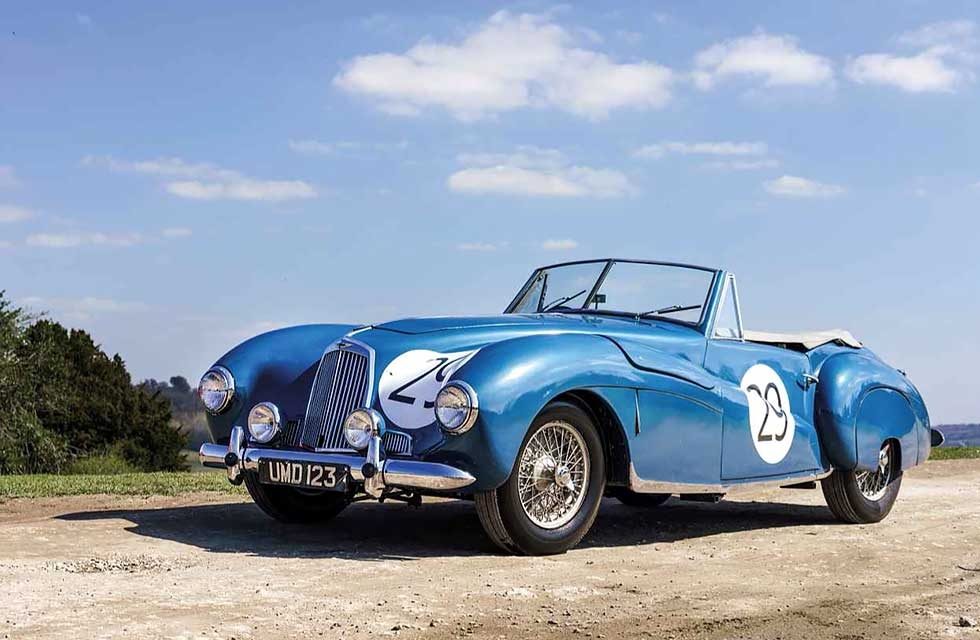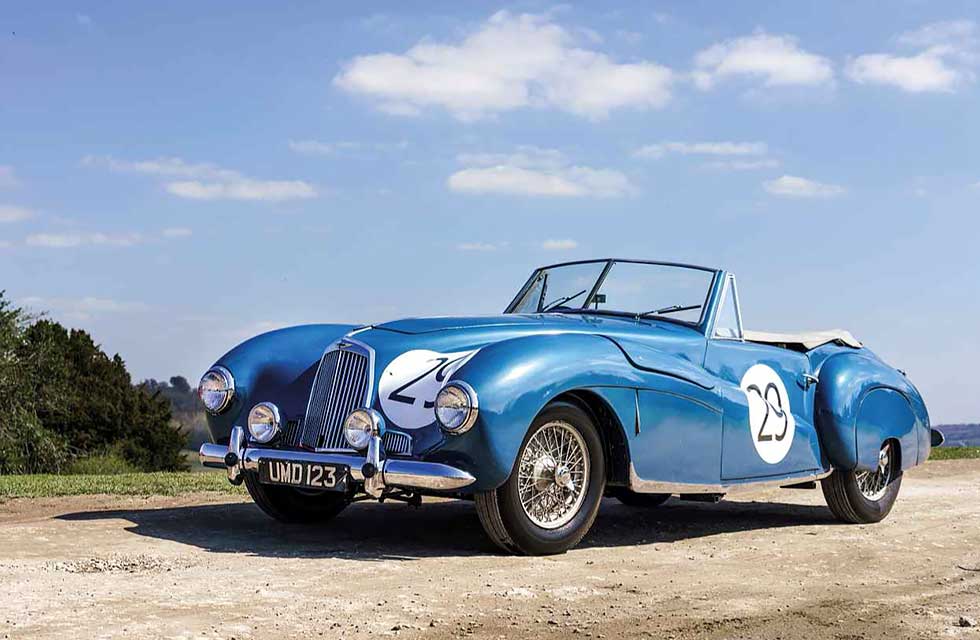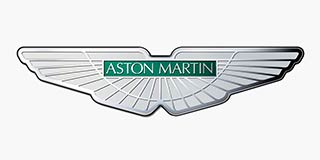
Another 24 Hours. Unlikely as it seems, 70 years ago this DB1 raced at Le Mans. We savour a racing Aston from a rather gentler age. Words John Simister. Photography Dean Smith.
LE MANS ASTONS DB1 LM From a gentler age, an unlikely Le Mans racer with a colourful history
The blue (slightly metallic) Aston Martin you see here has drum brakes. You would expect nothing else from a car of this era, discs being a few years from automotive adoption. Many people assume drum brakes to be rubbish, but they need not be so. Properly configured, properly adjusted and with shoes lined with suitable material, they can work very well.
‘It was all the more impressive for the facts that both drivers were aged 50 and neither had competed in a motor race before’

This car’s brakes, though, have just caused me to overshoot a layby from which I was planning to pick up our photographer, a few action shots having been completed. All my frantically increasing pedal pressure has achieved is a sense of something giving way beneath my right foot – a vital seal, perhaps – while forward motion suffers minimal attenuation. These linings surely consist mostly of PTFE, usefully heat-resistant as demonstrated by its presence in non-stick cookware but also noted for its minimal coefficient of friction.
‘The duo would have finished tenth but for a stop Parker made near the end to allow Lawrie to take over and drive it across the finishing line’
How this car would slow down at the end of the Mulsanne Straight at Le Mans, for example, is hard to imagine. It needs to be imagined, though, because in 1949 it was attempting to do just that. It must have succeeded because this 2 Litre Sports, with chassis number AMC /49/5 and registered UMD 123, finished in 11th place, one of only two Aston Martins to complete the race. The other was an early DB2 that came seventh, powered by the same type of Claude Hill-designed four-cylinder engine that failed to make it to production DB2s.
After this impressive showing, owner/driver Robert Lawrie and co-driver Richard Parker drove the Aston back home via an enjoyable, leisurely and gastronomically rewarding route. You couldn’t do that now in your 2018 Le Mans-winning Toyota hybrid with no proper room for a passenger or luggage nor even a road registration. Le Mans was different back then.
Adding to the Lawrie/Parker joy was that their DB1, as the model began to be known once the DB2 had appeared, finished fourth in its up-to-two-litre class. The entire feat was all the more impressive for the facts that both drivers were aged 50 and neither had competed in any form of motor race before. Back then, when rules were fewer and more bendable, such things were possible.
Lawrie, who would enter Le Mans three more times, finishing 11th again in 1951 in a Jaguar C-type, was a mountaineer and a manufacturer of exploration and hiking equipment: he equipped the 1953 expedition that reached the summit of Mount Everest, and in 1959 an Antarctic glacier was named after him. This was a man with a strong streak of determination.
During several visits to the French classic before the war, Lawrie had made friends with the officials of l’Automobile Club de l’Ouest (the ACO, today still the race’s organising body). The officials knew how keen he was to compete in what would be the first post-war Le Mans, especially when he told them he was having a car made specially for the event. At the 1948 Earl’s Court motor show, he had asked Aston Martin to make him a 2 Litre Sports like the production version revealed there to the world, but in lightly competition-flavoured trim. This was to include aero screens, a bonnet able to hinge along either side or be removed completely, and an engine with high- compression pistons as used in the minimally bodied 2 Litre Sports prototype that had won the Spa 24 Hours earlier in 1948.
Thus convinced, in March 1949 the ACO issued an official invitation to Lawrie to enter the 1949 race. The next hurdle was to acquire a competition licence for this international event, which the RAC did not normally issue to drivers of zero experience. But with friends like the ACO and David Brown to bring pressure, your chances of success are greatly enhanced. Messrs Lawrie and Parker duly got their licences.
All this was arranged via a series of letters, some of them styled as ‘bulletins’, setting out the plan of campaign, seeking a team manager, quoting advice Lawrie had received from famous Le Mans racer (and sports editor for The Autocar) S C H ‘Sammy’ Davis, relating the car’s build progress, deciding on routes pre- and post-race, and a whole lot more. There were discussions of lap speeds and driver stints, assessments of required equipment and all in the jovial tone of excited amateurs setting out on something between an expedition of geographical discovery and a very jolly jape. Parker named it Operation Greybeard.
For example: ‘S.C.H. Davies [sic] has strongly advised me to try and raise the loan of a large Golf Umbrella. Invaluable for pit work if it rains. Any offers???’
Or: ‘The A.C.O have asked me for a photograph of myself and one of Dick, I gather for publication in the French press. The only ones I could produce were of Dick looking like a Belsen thug, and one of me like a third-rate Shakespearian tragedian! France will laugh!’
As for the car itself, taking shape next to three other Le Mans entries, ‘On Tuesday last I spent the day at A.M’s and felt very cheered to see work in progress on our car. Countless little gnomes were busily screwing bits on, or filing bits off… I am due at Feltham again on Wednesday next to discuss various detail work with Messrs Hill, Sutherland and Jackson.’ That would be Claude Hill, the engine designer, and Gordon Sutherland, the creative force who was part of the pre-David Brown dynasty and who had put Aston Martin on the market in 1946.
The finished car was painted in Suffolk Green, and it ran beautifully at Le Mans. Lawrie was determined that it would finish the race, so he and Parker drove it merely briskly rather than permanently flat-out. The duo would have finished tenth but for a stop Parker made near the end to allow Lawrie to take over and drive it across the finishing line. That wouldn’t have happened in a modern Le Mans race either.
With its mission accomplished, UMD 123 was converted into a more road-friendly specification by having its aero screens replaced by the standard ‘vee’ windscreen with two glass panes, and its doors fitted with opening quarterlights. Soon afterwards it passed to second owner, Mr C Redhead, who is thought to have commissioned Aston’s service department to convert the DB1 to the specification it retains today: Botticelli Blue paint and a DB2-spec LB6-type straight-six engine of 2.6 litres. That would make it an Aston Martin 2.6 Litre Sports, had such a model existed.
The conversion happened in 1953, and the engine number (VB6B/50/51) suggests a unit of Aston Martin’s first Vantage specification: slightly higher compression and a 125bhp output. In later years the DB1 was returned to Suffolk Green, then it became blue again in the 1970s. Which is long enough ago for the paint to have patinated rather nicely.
So nicely, indeed, that it’s flaking away from a number of stress points on doors and panel junctions, but I don’t think you’d want to repaint UMD 123. This is a wonderfully, authentically, disreputably aged car, never restored, its panels fitting where they scuff, its hinges tired. In some ways it’s a prime restoration candidate but it seems a shame to eradicate all that history.
I drove another of the nine surviving DB1s (of 15 built) last year, Simon Draper’s beautifully restored and perfectly panel-gapped example that, as chassis number AMC/49/6, was the very next DB1 to be built after UMD 123. It shows what AMC /49/5, our car here, could be like, but even now it’s good enough to have room to get a lot worse before it is, one day perhaps, made much better.
Not all of its lights work, although a fine pair of Cibie Oscars sit incongruously up front. The trafficators are similarly unco-operative, so it’s a chance to rediscover how today’s drivers have no clue what old-fashioned hand signals mean. The centre armrest and the door provide the only lateral location on the flat bench seat with its two fold-down backrests, which must have been a good core-strengthening exercise during 24 hours of Le Mans lappery. But there’s a hefty three-spoke steering wheel to hold on to, adjustable in reach to make it either close or very close. A commemorative Le Mans plaque, detailing the 2616km and 716 metres covered in the 1949 race, sits proudly centre-dash. A silver shield celebrating the 11th place nestles nearby.
That straight-six sits so naturally under the bonnet that you would think it was designed to be there. It sounds keen and rich, the note of smooth power that befits an expensive British sports car and promises bigger thrills than a mere four-pot might offer. That promise fades on hills, but this DB1 can still cruise happily with modern motorway traffic as we find on the return run along the M40 to west London. It’s less happy on the subsequent stop / start crawl back to base, water temperature climbing as oil pressure sinks; an electric fan would be a justifiable departure from authenticity, I feel.
There is much else that is good about the way this up-engined DB1 with the uniquely intriguing race history moves. The gearchange is particularly precise and well-oiled, with effective synchromesh except on first gear, and unlike in the other DB1 of my experience the pedals are amenable to heel-and-toe downshifts. The steering, though loose around the centre, proves surprisingly light and fluid unless too much is asked of the front wheels’ Avon crossplies when heading into a bend.
Soft suspension gives a smooth if imprecise passage, although an occasional loud bang of metal-to-metal contact, accompanied by a structural shudder, suggests all is not optimal in the front suspension’s joints. The DB1’s responses would surely have been much sharper in 1949, and could be made so again. And then there are those brakes…
Were the car mine, I’d have these mechanical pecadilloes sorted out while retaining the well- worn, lived-in look. That would make a very usable and very appealing old Aston. And then there are its more recent adventures to add to its rakish allure. In 1994 it was sent from New Zealand, where then-owner Colin Gordon lived, to a buyer in Japan. But the DB1 was stolen from the Tokyo docks by the Yakuza, Japan’s mafia, and Gordon’s several attempts to regain possession over the next decade led to nothing – other than ‘a few broken ribs’.
In 2007, though, the Yakuza thief met a violent end, Gordon was finally able to reclaim his car through the Japanese courts, and his next attempt at selling it went much more smoothly. Now it’s for sale again. We all know about a certain silver Aston famously involved in tussles with powerful criminal syndicates, but they are only stories. For this blue one, it was real.
Clockwise from top left: Snapshots from the 1949 race; multi-way openable bonnet was a special feature requested by owner Lawrie with Le Mans in mind; 2.6-litre straight-six was fitted in 1953 in place of original ‘four’; cockpit ideal for a nice run through the French countryside… Left and above: A little gentle twisting of the rules saw owner/ driver Robert Lawrie and co-driver Richard Parker issued with national competition licences. Our man Simister finds the combination of corners and a bench seat gives the core muscles a good workout. Below and left: Le Mans 1949 and the DB1 (or 2 Litre Sports, as the model was originally known) defers to a works DB2. Seventy years later, it’s a charming period piece with a colourful past.
With thanks to DD Classics (dddassics.com), where the DB1 is for sale.
Specification
ENGINE In-line 6-cylinder, 2580cc (see text)
MAX POWER 125bhp @ 5000rpm
MAX TORQUE 144lb ft @ 2400rpm
TRANSMISSION Four-speed manual, rear-wheel drive
SUSPENSION Front: independent, leading links, coil springs, enclosed anti-roll bar, lever-arm dampers. Rear: live axle, coil springs, upper and lower radius arms, Panhard rod, telescopic dampers
STEERING Worm-and-roller, unassisted
BRAKES Drums front and rear
TYRES 6.00 H15 Avon Turbospeed
WEIGHT c1200kg
POWER TO WEIGHT c105bhp/ton
TOP SPEED c110mph
0-62mph 6.9sec






